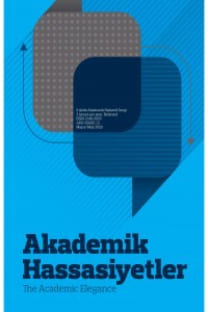GELİR DAĞILIMI EŞİTSİZLİĞİNİN İNSANİ GELİŞİME ENDEKSİ ÜZERİNDEKİ ETKİSİ: BRICS ÜLKELERİ İÇİN PANEL VERİ ANALİZİ
Gelir eşitsizliğinin insani gelişme endeksini (İGE) nasıl etkilediğini açıklamak çok boyutlu yoksulluk sorununun nereden kaynaklandığını anlamak için çok önemlidir. Bu çalışma, Brezilya, Rusya, Hindistan, Çin ve Güney Afrika Cumhuriyeti (BRICS) için İGE ve gelir dağılımı eşitsizliğini gösteren Gini katsayısını birlikte analiz etmeyi ve böylece gelir dağılımı eşitsizliğinin İGE’yi nasıl etkilediğini anlamayı amaçlamaktadır. Bu kapsamda BRICS ülkelerinin 1990-2018 dönemi Gini katsayısı bağımsız değişken, İGE de bağımlı değişken olarak modele dahil edilmiş ve panel veri analizi yöntemi ile analiz edilmiştir. Ayrıca modele açıklayıcı değişken olarak ekonomik büyüme eklenmiştir. Bu analizde, yatay kesit bağımlılığı ve eşbütünleşme testi yapıldıktan sonra katsayı homojenliği bulunamadığı ve birimler arasında korelasyon olduğu için katsayı tahmini için Artırılmış Ortalama Grup Tahmincisi (AMG) kullanılmıştır. Sonuç olarak BRICS ülkeleri grubunda Gini katsayısı ile İGE arasında istatistiksel olarak anlamlı bir ilişkinin olmadığı tespit edilmiştir. Ancak ülke bazlı analizler incelendiğinde Gini katsayısındaki değişimlerin Brezilya ve Rusya'da İGE'yi etkilediği görülmektedir. Bu etki Brezilya'da ters yönlü iken; Rusya'da doğrusaldır.
Anahtar Kelimeler:
Gini Katsayısı, İnsani Gelişme Endeksi, BRICS, Genişletilmiş Ortalama Grup Tahmincisi
IMPACT OF INCOME DISTRIBUTION INEQUALITY ON THE HUMAN DEVELOPMENT INDEX: PANEL DATA ANALYSIS FOR BRICS COUNTRIES
Understanding how income inequality affects the human development index (HDI) is crucial to understand where the multidimensional poverty problem originates from. The Gini coefficient expresses income inequality and allows the comparison of income distributions between countries. This study aims to use the HDI and the Gini coefficient, which shows the income distribution inequality, to analyse Brazil, Russia, India, China, and the Republic of South Africa (BRICS countries) and thus to understand how the income distribution inequality influences the human development index values. In this context, the Gini coefficient of the BRICS countries for the period 1990-2018 was analyzed with the panel data analysis method as the independent and the HDI data as the dependent variable. In addition, the economic growth variable was added as an explanatory variable to the model. In this analysis, the Augmented Mean Group Estimator (AMG) was used because the coefficient homogeneity could not be found after the cross-section dependence and cointegration test was performed and there was a correlation between the units. As a result, it was determined that there was no statistically significant relationship between the Gini coefficient and the HDI among BRICS countries. However, country-based showed that the changes in the Gini coefficient affected HDI in Brazil and Russia. While the direction of this effect was opposite in Brazil, it was linear in Russia.
___
- Alvan, A. (2009). Forging a link between Human Development and Income Inequality: Cross-Country Evidence, Review of Social, Economic & Business Studies, 7(8), 31-43 .
- Baltagi, B., Feng, Q., and Kao, C. (2012). A Lagrange Multiplier Test For Cross-Sectional Dependence In A Fixed Effects Panel Data Model. Journal of Econometrics, 170 (1): 164-177.
- Breusch, T., and Pagan, A. (1980) The Lagrange Multiplier Test and Its Application to Model Specification in Econometrics. Review of Economic Studies, 47: 239-254.
- Ceesay, E. K. & Fanneh, M. M. & Tsenkwo, J. (2019). Effect of Income Inequality on Economic Growth in Selected West Africa Countries: An Empirical Analysis. BİLTÜRK, The Journal of Economics and Related Studies, 1 (3), 240- 257.
- Dumitrescu, E. I. and Hurlin, C., (2012). Testing for Granger Noncausality in Heterogeneous Panel. Economic Modelling, 29(4):1450-1460.
- Eberhardt, M., and Teal F. (2010). Productivity Analysis in Global Manufacturing Production. Discussion Paper 515, Department of Economics, University of Oxford.
- Hysa, E. (2014). Inequality and Human Development Correlation in Albania. In Proceedings in GV-Global Virtual Conference (No. 1).
- Mikk, J. (2008). The Role of Income Inequality in Human Development. Socialiniai tyrimai / Social Research. 4 (14), 78–83.
- Mo, P. H. (2000). Income Inequality and Economic Growth. Kyklos, 53: 293-315. https://doi.org/10.1111/1467-6435.00122
- Pesaran, M. H. (2003). A Simple Panel Unit Root Test in The Presence of Cross-Section Dependence, Cambridge Working Papers in Economics, 0346. http://www.econ.cam.ac.uk/research-files/repec/cam/pdf/cwpe0346.pdf
- Pesaran, M. H. (2004). General Diagnostic Tests for Cross Section Dependence in Panels, Discussion Papers on IZA, Discussion Paper No. 1240. https://doi.org/10.17863/CAM.5113
- Pesaran, M. H. and Yamagata, T. (2008). Testing Slope Homogeneity in Large Panels. Journal of Econometrics, 142(1),
- Sarkodie S. A. and Adams S. (2020). Electricity access, human development index, governance and income inequality in Sub-Saharan Africa, Energy Reports,6, pp. 455-466, https://doi.org/10.1016/j.egyr.2020.02.009.
- Swamy, P. A. V. (1970) “Efficient Inference in a Random Coefficient Regression Model”. Econometrica 38: 311–323.
- Theil, F. (2016). The Effect of Inequality on (Human) Development – Insights from a Panel Analysis of the Human Development Index, Master Thesis, Universidat de Barcelona, http://diposit.ub.edu/dspace/bitstream/2445/100229/1/Master-
- ThielFabian.pdf
- UN, Human Development Report 2007/2008, United Nation Development Programme, http://hdr.undp.org/en/content/human-development-report-20078
- Westerlund, J. and Edgerton, D.L. (2008), A Simple Test for Cointegration in Dependent Panels with Structural Breaks. Oxford Bulletin of Economics and Statistics, 70: 665-704. https://doi.org/10.1111/j.1468-0084.2008.00513.x
- ISSN: 2148-5933
- Yayın Aralığı: Yılda 3 Sayı
- Başlangıç: 2014
- Yayıncı: A Kitap
Sayıdaki Diğer Makaleler
BİRLEŞİK KRALLIK'TAKI TÜRKİYE KÖKENLI İNGİLİZ VATANDAŞLARININ SİYASETE KATILIMINDA KURUMLARIN ROLÜ
Mikail PEHLİVAN, Abdurrahman KAYA, Seda Selin KELEŞ
Gülşah GENÇER ÇELİK, Gökten ÖNGEL
HALKLA İLİŞKİLER İÇİN BİR PARADİGMA ÖNERİSİ
TÜRKİYE’DE MALİYE POLİTİKASI İLE EKONOMİK BÜYÜME ARASINDAKİ UZUN VADELİ İLİŞKİ
BİRLEŞİK KRALLIK'TAKI TÜRKİYE KÖKENLI İNGİLİZ VATANDAŞLARININ SİYASETE KATILIMINDA KURUMLARIN ROLÜ
